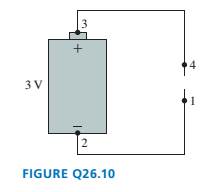
FIGURE Q26.10 shows a 3 V battery with metal wires attached to each end. What are the potential differences

Want to see the full answer?
Check out a sample textbook solution
Chapter 26 Solutions
PHYS 212 FOR SCI+ENG W/MAST PHYS >ICP<
- Figure P27.75 shows four capacitors with CA = 4.00 F, CB = 8.00 F. CC = 6.00 F. and CD = 5.00 F connected across points a and b, which have potential difference Vab = 12.0 V. a. What is the equivalent capacitance of the four capacitors? b. What is the charge on each of the four capacitors?arrow_forwardA Pairs of parallel wires or coaxial cables are two conductors separated by an insulator, so they have a capacitance. For a given cable, the capacitance is independent of the length if the cable is very long. A typical circuit model of a cable is shown in Figure P27.87. It is called a lumped-parameter model and represents how a unit length of the cable behaves. Find the equivalent capacitance of a. one unit length (Fig. P27.87A), b. two unit lengths (Fig. P27.87B), and c. an infinite number of unit lengths (Fig. P27.87C). Hint: For the infinite number of units, adding one more unit at the beginning does not change the equivalent capacitance.arrow_forwardAn arrangement of capacitors is shown in Figure P27.23. a. If C = 9.70 105 F, what is the equivalent capacitance between points a and b? b. A battery with a potential difference of 12.00 V is connected to a capacitor with the equivalent capacitance. What is the energy stored by this capacitor? Figure P27.23 Problems 23 and 24.arrow_forward
- Given the arrangement of capacitors in Figure P27.23, find an expression for the equivalent capacitance between points a and b. Figure P27.23 Problems 23 and 24.arrow_forwardProblem 2: Three capacitors are connected as shown in the figure. C; = 6.8 µF, C2 = 8.2 µF, C3 = 6.7 µF. The voltage on the battery is 12 V. Part (a) Express the equivalent capacitance of the two capacitors C, and C2 in terms of the variables given in the problem statement. C12 = AV HOME C1 4 5 6 C12 C2 C3 1 2 3 d h +| - END P Vol BACKSPACE DEL CLEAR Part (b) Using the above result, express the total capacitance in terms of C12 and C3. Part (c) Calculate the numerical value of the total capacitance in uF. Part (d) Express the charge Q stored in the circuit in terms of capacitance C and the potential difference AV across the battery. Part (e) Calculate the numerical value of Q in uC. Part (f) Express the energy stored in a capacitor in terms of capacitance C and the potential difference AV. Part (g) Calculate the numerical value of U in µJ.arrow_forwardSuppose a 110-V battery is connected to 5 capacitors in parallel. The values are C= 33 µF, C2= 45 µF, C3= 24 uF, C4= 50 µF and C= 15 u What is the voltage across the 24 uF capacitor? O 22V O 36.7 V O 55 V O 110 Varrow_forward
- What is |λ|? A very long wire carries a uniform linear charge density λ. Using a voltmeter to measure potential difference, you find that when one probe of the meter is placed 4.90 cm from the wire and the other probe is 3.10 cm farther from the wire, the meter reads 620 V.arrow_forwardA pair of capacitors C1 = 39.0 µC and C2 = 24.0 µC are connected to a battery V = 54.0 V and a switch. The capacitors are initially uncharged. After the switch has been closed and the capacitors are fully charged, what is the ratio V2/Vị of the voltages across the capacitors, where Vị is the voltage across C1 and V2 is the voltage across C2? C1 C2 Vp O (a) 0.615 O (b) 1.62 O (c) 0.379 O (d) 2.64 О (e) 1arrow_forwardThree capacitors are connected as shown in the figure. C1 = 4.4 μF, C2 = 14.4 μF, C3 = 2.1 μF. The voltage on the battery is 12 V. Part (a) Express the equivalent capacitance of the two capacitors C1 and C2 in terms of the variables given in the problem statement. C12 = C1 + C2 ✔ Correct! Part (b) Using the above result, express the total capacitance in terms of C12 and C3. C = ( C3 C12 )/( C3 + C12 ) ✔ Correct! c. Calculate the numerical value of the total capacitance in μF. d. Express the charge Q stored in the circuit in terms of capacitance C and the potential difference ΔV across the battery. Q = C ΔV ✔ Correct! e. Calculate the numerical value of Q in μC. (f) Express the energy stored in a capacitor in terms of capacitance C and the potential difference ΔV. (g) Calculate the numerical value of U in μJ. I need help with c, d, e, f, and garrow_forward
- Where a 2.7 V battery is connected to a network of capacitors with C1 = 54 F, C2 = 63 F, and C3 = 45 F. What is the potential difference across C3? (in V)a. 2.16 Vb. 2.70 Vc. 0.900 Vd. 1.35 Varrow_forwardTwo capacitors in series, C1= 9.0 uF and C2= 5.0 uF, are connected to a 12.0 V battery. What is the potential difference in C1? 12 V 6V 7.1 V 4.28 Varrow_forwardO 54 V 24 V 60 V 36 V O 3 V E 90 V 18 V 30 V a b 15 uF 3 μF Consider the circuit shown in the figure. If the potential difference for 12-uF capacitor is 3 V, what is the potential difference & for the battery? 7.5 µF 4 μF HH 12 µF 6 μFarrow_forward
 Physics for Scientists and Engineers: Foundations...PhysicsISBN:9781133939146Author:Katz, Debora M.Publisher:Cengage Learning
Physics for Scientists and Engineers: Foundations...PhysicsISBN:9781133939146Author:Katz, Debora M.Publisher:Cengage Learning Principles of Physics: A Calculus-Based TextPhysicsISBN:9781133104261Author:Raymond A. Serway, John W. JewettPublisher:Cengage Learning
Principles of Physics: A Calculus-Based TextPhysicsISBN:9781133104261Author:Raymond A. Serway, John W. JewettPublisher:Cengage Learning

